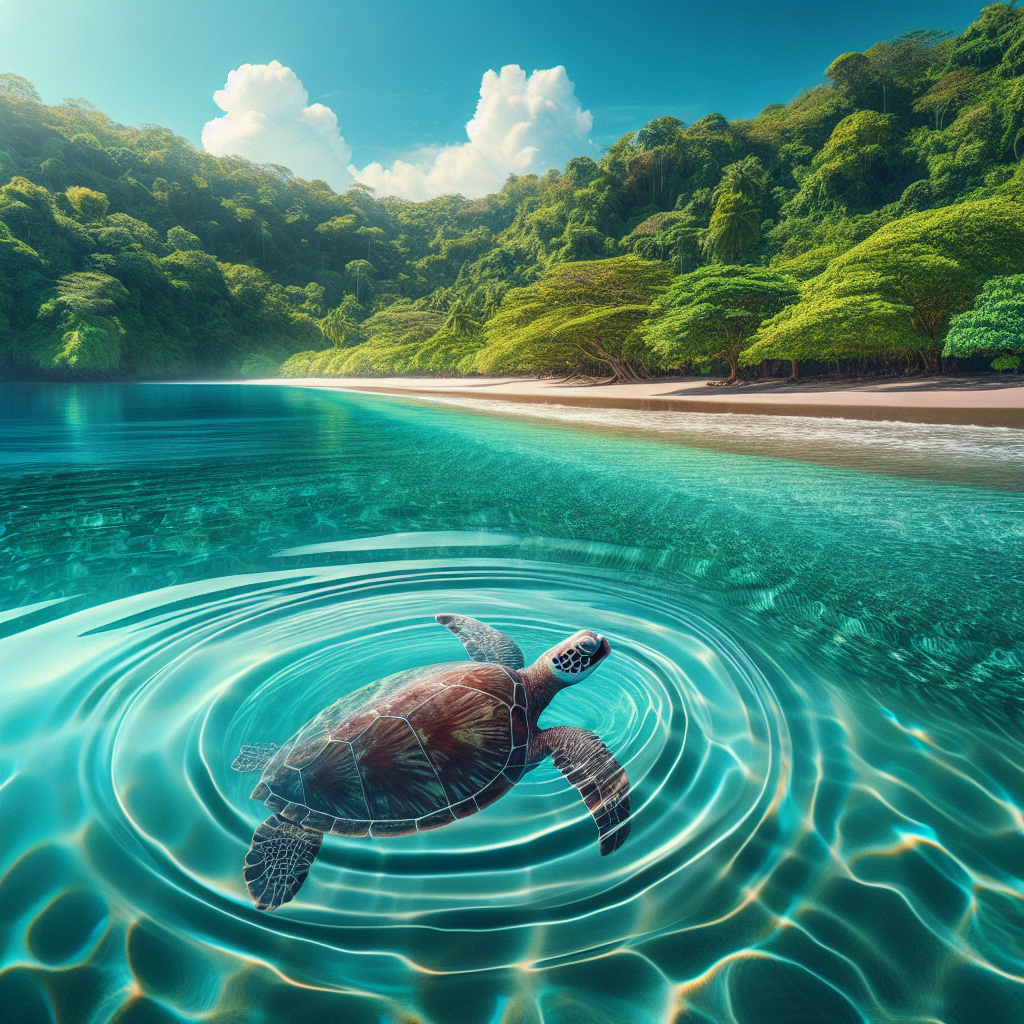Nicaragua’s pristine beaches offer more than just a picturesque escape; they serve as an idyllic haven for wildlife enthusiasts. From sea turtles nesting to the mesmerizing sight of dolphins frolicking in the waves, Nicaragua’s diverse ecosystem boasts a myriad of incredible species. Whether you’re an avid birder or simply curious about the fascinating world of marine life, this article will guide you through the best beaches that Nicaragua has to offer for unforgettable wildlife observation experiences.
Playa La Flor, San Juan del Sur
Location
Located in the southwestern corner of Nicaragua, Playa La Flor is situated in the town of San Juan del Sur. This beautiful beach offers an idyllic setting surrounded by lush forests and dramatic cliffs. It is easily accessible by road, making it a popular destination for tourists looking to explore Nicaragua’s natural beauty.
Wildlife Viewing
Playa La Flor is famous for its incredible wildlife viewing opportunities. It is a nesting site for four species of sea turtles, including the critically endangered Pacific leatherback turtle. These majestic creatures can be observed during the nesting season, which typically runs from July to January. Witnessing the sight of these massive turtles coming ashore to lay their eggs is truly a once-in-a-lifetime experience.
In addition to sea turtles, Playa La Flor also offers the chance to spot other coastal wildlife such as hermit crabs, pelicans, and iguanas. The beach is home to a rich ecosystem, and with a bit of patience, you may even catch a glimpse of dolphins playing in the ocean waves.
Conservation Efforts
To preserve the delicate nesting habitat of the sea turtles, Playa La Flor has implemented conservation efforts. The beach is part of the Padre Ramos Nature Reserve, which is dedicated to protecting the region’s biodiversity. Rangers patrol the beach during nesting season to ensure the safety of the nesting turtles and their eggs.
Visitors to Playa La Flor are required to follow strict guidelines to minimize their impact on the nesting turtles. These guidelines include avoiding flash photography, keeping a safe distance from the turtles, and refraining from touching or disturbing their nests. By adhering to these guidelines, visitors can contribute to the ongoing conservation efforts and help protect the nesting grounds of these magnificent creatures.
Cosiguina Peninsula Wildlife Refuge
Location
Situated in northwestern Nicaragua, the Cosiguina Peninsula Wildlife Refuge is a hidden gem for wildlife enthusiasts. It is located near the town of El Viejo, just a short distance from the Honduran border. The refuge can be accessed by boat or by hiking through the rugged terrain, offering adventurers an exciting journey to reach its pristine beaches.
Wildlife Viewing
The Cosiguina Peninsula Wildlife Refuge is renowned for its diverse wildlife. The area is home to a variety of bird species, including parrots, toucans, and herons. Birdwatchers will delight in the opportunity to spot these colorful creatures in their natural habitat.
In addition to birds, the refuge is also home to several species of monkeys, including howler and spider monkeys. Exploring the forest trails, you may be lucky enough to witness these playful primates swinging through the treetops.
Activities
Aside from wildlife viewing, the Cosiguina Peninsula Wildlife Refuge offers visitors a range of activities to enjoy. Hiking trails wind through the lush landscape, providing breathtaking views of the surrounding mountains and coastline. The volcanic craters and lava fields showcase the area’s geological history, and visitors can embark on guided tours to learn more about the region’s volcanic past.
For those seeking a more serene experience, the refuge’s tranquil beaches are perfect for swimming and sunbathing. The untouched coastline offers a peaceful retreat away from the crowds, allowing visitors to reconnect with nature and soak in the beauty of their surroundings.

Montecristo Beach
Location
Nestled along Nicaragua’s Pacific coast, Montecristo Beach is located in the department of Chinandega. This secluded paradise is surrounded by lush vegetation and offers visitors a tranquil escape from the hustle and bustle of everyday life. Accessible by both land and sea, reaching Montecristo Beach is an adventure in itself.
Wildlife Viewing
Montecristo Beach is a haven for wildlife enthusiasts. Its unspoiled mangrove estuary provides a sanctuary for a wide variety of bird species, including herons, roseate spoonbills, and kingfishers. Birdwatchers can spend hours observing these graceful creatures as they feed and nest in the mangroves.
The rich marine ecosystem along Montecristo Beach also offers opportunities for encounters with playful dolphins. These intelligent creatures can often be spotted frolicking in the waves, providing a memorable experience for visitors of all ages.
Accessibility
While the beauty of Montecristo Beach lies in its remote location, it is still relatively accessible for visitors. The beach can be reached by a combination of land and boat travel, ensuring that the journey is as enjoyable as the destination itself.
Visitors can arrive at Montecristo Beach by car or bus, followed by a picturesque boat ride through the mangroves. This journey allows travelers to immerse themselves in the natural beauty of the area, slowly transitioning from the mainland to the serene coastal paradise.
Conservation Efforts
To preserve the pristine beauty of Montecristo Beach, conservation efforts have been implemented in the area. Local organizations work tirelessly to protect and restore the mangrove forests, ensuring that the delicate balance of the ecosystem is maintained.
Visitors are encouraged to respect the natural surroundings and adhere to sustainable tourism practices. By minimizing their impact on the environment and supporting local conservation initiatives, visitors can play a significant role in preserving the ecological integrity of Montecristo Beach for future generations.
Pearl Cays
Location
Located along Nicaragua’s Caribbean coast, the Pearl Cays are a group of small islands near the city of Bluefields. This remote and untouched destination is a true tropical paradise, with crystal-clear waters and abundant marine life. Accessible only by boat, the Pearl Cays offer a secluded getaway for those seeking an escape from the crowds.
Wildlife Viewing
The Pearl Cays are a haven for wildlife enthusiasts, providing opportunities to witness marine creatures in their natural habitat. The warm Caribbean waters surrounding the islands are home to an array of colorful fish and coral reefs. Snorkeling or diving in these pristine waters allows visitors to get up close and personal with this vibrant underwater world.
One of the main attractions of the Pearl Cays is the chance to encounter dolphins. These playful creatures are often spotted swimming alongside boats or leaping out of the water, creating unforgettable moments for lucky spectators.
Turtle Nesting
For those visiting the Pearl Cays between May and November, witnessing the nesting of sea turtles is a highlight. The beaches of the islands are important nesting grounds for various turtle species, including hawksbill and green turtles. Watching these ancient creatures lay their eggs in the soft sand is a truly mesmerizing experience.
Local organizations and communities in the Pearl Cays are committed to protecting the nesting turtles and their eggs. Measures have been implemented to prevent poaching and ensure that the turtles can safely lay their eggs undisturbed. By supporting responsible tourism practices, visitors can contribute to the conservation efforts and help preserve the fragile ecosystem of the Pearl Cays.

Estero Padre Ramos Nature Reserve
Location
Situated on Nicaragua’s Pacific coast, the Estero Padre Ramos Nature Reserve is located near the town of Chinandega. Spanning an area of approximately 4,000 hectares, the reserve is a significant wetland ecosystem teeming with diverse wildlife. Its strategic location along the migratory bird flyway makes it a prime spot for bird watching.
Wildlife Viewing
Estero Padre Ramos Nature Reserve offers wildlife enthusiasts an unparalleled chance to observe a wide range of species in their natural habitat. The reserve is home to extensive mangrove forests, serving as a nursery and feeding ground for various fish and bird species. Exploring the labyrinth of mangrove channels by boat or kayak provides a unique opportunity to witness this vibrant ecosystem up close.
Birdwatchers will be delighted by the plethora of avian species that call Estero Padre Ramos home. From elegant herons to striking kingfishers, the reserve attracts a diverse range of birds throughout the year. Capture the sight of a graceful egret taking flight or a flock of ibis feeding on the mudflats – the possibilities for bird watching are endless.
Mangrove Forests
The mangrove forests of Estero Padre Ramos are not only visually stunning but also serve as vital habitat for numerous marine and terrestrial species. These unique ecosystems offer protection from storms and act as natural water filters, improving water quality and enhancing the overall health of the surrounding environment.
Visitors to the reserve can explore the winding mangrove channels by boat or kayak, immersing themselves in the tranquility of these ancient forests. As you navigate through the dense mangroves, keep an eye out for the diversity of plant and animal life that call these forests home.
Bird Watching
Estero Padre Ramos Nature Reserve is a paradise for birdwatchers. With over 100 bird species recorded in the area, it is a must-visit destination for any avian enthusiast. Whether you are an experienced birder or a novice, the reserve offers ample opportunities to spot and observe a wide variety of feathered creatures.
Guided bird watching tours are available within the reserve, led by knowledgeable local guides who can help identify different species and share interesting facts about their behavior. Don’t forget to bring your binoculars and camera to capture the beauty of the colorful birds in their natural habitat.
Jiquilillo Bay
Location
Nestled along Nicaragua’s northwest coast, Jiquilillo Bay is a small, laid-back fishing village that offers a glimpse into the country’s authentic coastal lifestyle. This hidden gem is located in the department of Chinandega and is easily accessible by road. With its pristine beaches and uncrowded waves, Jiquilillo Bay is a great destination for those seeking relaxation and adventure.
Wildlife Viewing
Jiquilillo Bay is a paradise for wildlife enthusiasts, providing ample opportunities to observe a diverse range of species. The bay is famous for its turtle conservation efforts, with Olive Ridley and Pacific green turtles nesting on its shores. Witnessing the turtles emerge from the water to lay their eggs is a truly awe-inspiring experience.
In addition to turtles, Jiquilillo Bay is home to a variety of bird species such as frigatebirds, herons, and pelicans. Taking a stroll along the shoreline or exploring the nearby estuaries offers the chance to spot these majestic creatures in their natural habitat.
Turtle Conservation
One of the main draws of Jiquilillo Bay is its commitment to turtle conservation. Local organizations have implemented programs to protect nesting turtles and their eggs, ensuring the survival of these ancient creatures. Visitors can learn about the conservation efforts and even participate in the release of baby turtles, contributing to the ongoing conservation work.
Surfing
Aside from wildlife viewing, Jiquilillo Bay is also a popular destination for surfers. The bay’s consistent waves provide ideal conditions for both beginners and experienced surfers alike. Whether you’re looking to catch your first wave or improve your skills, the friendly local surf schools offer lessons and board rentals.
After a day of adrenaline-pumping surf sessions, relax on the beach and soak in the stunning sunsets that illuminate the bay. Jiquilillo Bay is a hidden gem that combines thrilling outdoor activities with the opportunity to connect with nature in a tranquil setting.

Maderas Beach
Location
Situated on Nicaragua’s Pacific coast, Maderas Beach is a picturesque destination that attracts beach lovers and adventure enthusiasts alike. Located near the town of San Juan del Sur, it is easily accessible by road, making it a popular spot for both locals and tourists to enjoy the pristine coastline.
Wildlife Viewing
Maderas Beach offers a unique wildlife viewing experience, with a variety of species inhabiting its surrounding forests and ocean waters. The forested hills that border the beach are home to howler monkeys, which can often be spotted swinging through the treetops. Their distinctive calls echo through the jungle, adding to the magical ambiance of this natural paradise.
The ocean waters of Maderas Beach are teeming with marine life, making it an excellent spot for snorkeling or diving. Colorful tropical fish, rays, and even the occasional sea turtle can be observed as you explore the underwater world. Don’t forget to bring your snorkeling gear and immerse yourself in the beauty of the coral reefs.
Hiking
For those seeking adventure and breathtaking views, Maderas Beach offers an array of hiking trails. The hills surrounding the beach are adorned with lush vegetation, providing an ideal setting for hiking enthusiasts. Trek through dense forests, where you may encounter exotic bird species and other wildlife along the way.
One of the most popular hiking destinations near Maderas Beach is the hike to the summit of Volcan Maderas. This dormant volcano offers a challenging yet rewarding trek, culminating in panoramic views of the surrounding landscape and the pristine coastline below. As you ascend to the summit, take in the sights and sounds of nature, and be prepared for an unforgettable hiking experience.
Water Activities
Maderas Beach is a haven for water enthusiasts, offering a wide range of activities to enjoy. Apart from snorkeling and diving, visitors can also go kayaking or paddleboarding along the tranquil waters. Exploring the coastline from the water allows a unique perspective on the surrounding landscape, creating a sense of harmony with nature.
After a day filled with water adventures, relax on the beach and soak in the sun’s rays. Maderas Beach’s golden sands and gentle waves provide the perfect backdrop for leisurely beachcombing or simply unwinding with a good book. Whether you’re seeking adrenaline-pumping activities or simply a place to relax, Maderas Beach has something to offer for everyone.
El Ostional Wildlife Refuge
Location
Located along Nicaragua’s Pacific coast, the El Ostional Wildlife Refuge is situated near the town of San Juan del Sur. This protected area encompasses both land and sea, providing a sanctuary for a variety of marine and terrestrial species. El Ostional is easily accessible by road, making it a convenient destination for wildlife enthusiasts.
Wildlife Viewing
El Ostional Wildlife Refuge is renowned for its arribadas, a natural phenomenon where thousands of sea turtles come ashore to nest simultaneously. The refuge serves as a critical nesting ground for Olive Ridley turtles, attracting these ancient creatures in large numbers. Witnessing the arrival of the turtles and the subsequent egg-laying process is an unforgettable experience.
In addition to sea turtles, El Ostional is home to a diverse range of wildlife. The sandy beaches and surrounding forested areas provide habitat for various bird species, including frigatebirds, pelicans, and sandpipers. Exploring the refuge offers the opportunity to observe these winged creatures in their natural habitat.
Arribadas
Arribadas are a unique spectacle found in only a few places around the world, and El Ostional Wildlife Refuge is one of them. During an arribada, thousands of female sea turtles emerge from the ocean to lay their eggs, creating a truly awe-inspiring sight. These mass nesting events usually occur a few times a month, coinciding with the lunar cycle.
To witness an arribada, it is important to visit the refuge during the nesting season, which typically occurs from July to January. Guided tours are available to provide insights into the nesting behavior of the turtles while ensuring minimal disruption to their natural process. By following the guidance of experienced guides, visitors can both enjoy the spectacle of the arribadas and contribute to the conservation efforts.
Conservation Efforts
El Ostional Wildlife Refuge has long been dedicated to the conservation of sea turtles and their nesting grounds. The local community plays an active role in protecting the turtles and their nests, implementing measures to prevent poaching and minimize disturbance to the nesting process.
Visitors to the refuge are required to follow specific guidelines to ensure the well-being of the nesting turtles. These guidelines include maintaining a safe distance from the turtles, avoiding the use of flash photography, and refraining from disturbing their nests. By respecting these guidelines and supporting the refuge’s conservation efforts, visitors can help preserve the fragile ecosystem and contribute to the survival of these magnificent creatures.

Pochomil Beach
Location
Situated along Nicaragua’s Pacific coast, Pochomil Beach is located in the municipality of San Rafael del Sur. This popular beach destination is easily accessible from the country’s capital, Managua, making it a convenient choice for both locals and tourists. Pochomil Beach offers a mix of natural beauty and vibrant local culture, making it an ideal getaway.
Wildlife Viewing
Pochomil Beach is a fantastic destination for wildlife observation, particularly for avid birdwatchers. The beach’s tranquil setting is home to a variety of bird species, including herons, frigatebirds, and sandpipers. Delight in the sight of these elegant creatures as they fish in the shallow waters and glide gracefully through the sky.
In addition to birds, Pochomil Beach is also inhabited by various reptiles, such as iguanas and lizards. These scaly creatures can often be spotted sunning themselves along the sandy shores or taking cover beneath the mangrove trees that dot the coastline.
Bird Watching
The diverse bird population at Pochomil Beach makes it an excellent destination for bird watching enthusiasts. The beach’s proximity to wetlands and estuaries provides an ideal habitat for a wide range of avian species. Bring your binoculars and camera, and embark on a bird watching adventure along the beach or the nearby lagoons.
To enhance your bird watching experience, consider joining a guided tour led by knowledgeable local guides. These experts can provide valuable insights into the behaviors and habits of the birds, enhancing your appreciation for the natural wonders of Pochomil Beach.
Water Sports
Beyond its wildlife viewing opportunities, Pochomil Beach offers a host of water sports activities for adventurous visitors. Whether you’re an experienced surfer or a novice looking to catch your first wave, the beach’s consistent surf breaks provide ideal conditions for all skill levels. Surf schools and board rentals are available, ensuring that everyone can enjoy the thrill of riding the waves.
Apart from surfing, Pochomil Beach is also a popular destination for other water sports such as kayaking, paddleboarding, and jet skiing. Explore the coastline from a different perspective or embark on a thrilling water adventure – the choice is yours.
After a day of excitement on the water, sit back, relax, and enjoy the stunning sunsets that paint the sky with vibrant hues. Pochomil Beach’s golden sands and tranquil atmosphere provide the perfect setting for unwinding and reflecting on the beauty of nature.
Corn Islands
Location
Located off the eastern coast of Nicaragua in the Caribbean Sea, the Corn Islands are a paradise waiting to be discovered. Consisting of Big Corn Island and Little Corn Island, these idyllic destinations offer a tropical escape like no other. The islands can be reached by either a short flight or a ferry ride from the mainland.
Wildlife Viewing
The Corn Islands boast a rich marine ecosystem, making them a haven for wildlife enthusiasts. The crystal-clear waters surrounding the islands are teeming with vibrant coral reefs and tropical fish. Grab your snorkeling gear and explore the underwater world, where you can spot colorful parrotfish, angelfish, and even harmless nurse sharks.
The islands are also home to various bird species, such as frigatebirds and tropicbirds. Take a leisurely stroll along the beaches or through the island’s lush interior, and keep an eye out for these feathered creatures as they soar through the skies or nest in the treetops.
Snorkeling
Snorkeling is a popular activity on the Corn Islands, and for good reason. The islands’ coral reefs offer excellent snorkeling opportunities, allowing visitors to get up close and personal with the abundant marine life. Snorkel through coral gardens, swim alongside schools of tropical fish, and marvel at the intricate and colorful coral formations.
The calm and clear waters make the Corn Islands an ideal destination for snorkelers of all levels, from beginners to experienced enthusiasts. Snorkeling gear is readily available for rent on the islands, making it easy to dive right in and explore the beauty that lies beneath the surface.
Marine Life
The Corn Islands are famous for their diverse marine life. In addition to the array of colorful fish, lucky snorkelers may also encounter larger sea creatures, such as sea turtles and rays. Little Corn Island is known for its resident reef sharks, which can be observed from a safe distance.
For a truly memorable experience, consider taking a snorkeling or diving excursion to Blowing Rock. Located a short boat ride from Little Corn Island, this volcanic rock formation is home to an abundance of marine life, including barracudas, moray eels, and even the occasional hammerhead shark. Dive into the crystal-clear waters surrounding Blowing Rock and explore this underwater wonderland.
In conclusion, Nicaragua offers a multitude of beach destinations that not only provide picturesque landscapes but also offer incredible wildlife viewing opportunities. From the nesting sea turtles of Playa La Flor and El Ostional Wildlife Refuge to the colorful marine life of the Pearl Cays and the Corn Islands, there is something for every nature lover. Visitors can participate in conservation efforts, embark on bird watching adventures, snorkel among vibrant coral reefs, and immerse themselves in the natural beauty of Nicaragua’s coast. Whether you’re seeking adventure, relaxation, or a combination of both, Nicaragua’s beaches have it all. So pack your binoculars, grab your snorkeling gear, and get ready to explore the best beaches in Nicaragua for wildlife observation.

